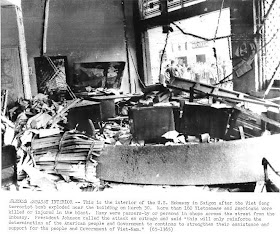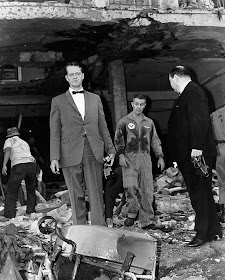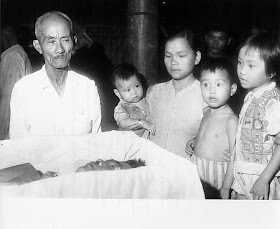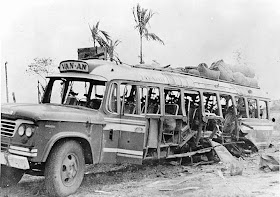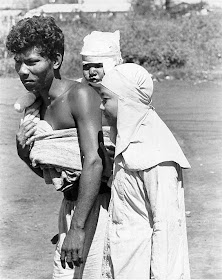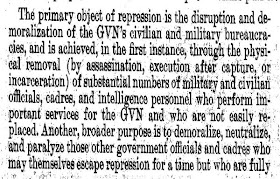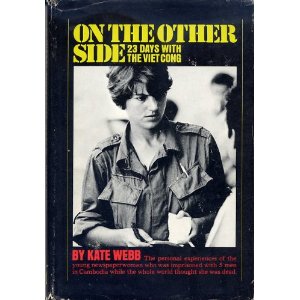The Vietnam War was a nightmare for the people of Vietnam. Both sides killed innocent civilians caught up in the conflict. We have heard of My Lai. We have also heard of the brutal ways of the South Vietnamese Army.
The Vietcong are portrayed as freedom fighters. But they too were no angels. The massacre at Hue is well known.
In fact many say, now there is Al Qaeda, then it was the Vietcong....
We shall look at instances where the Vietcong too went bad....
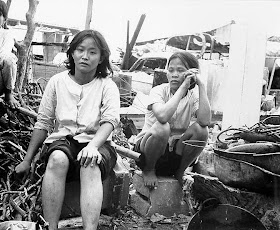 |
| Victims of a Viet Cong attack on Sam Bua hamlet, Vinh Binh Province, on July 8, 1967, sit beside their destroyed homes. |
 |
| Victims Of Dak Son Massacre Await Burial Bodies wrapped in available material await burial in one of the few remaining huts. These bodies were removed from a tunnel shelter. |
On 5 December 1967 the NLF guerrillas attacked a South Vietnamese village Dakson and killed at least 250 civilians.
In June 1968 the NLF guerrillas attacked a South Vietnamese village Shoncha, killing 88 and wounding over 100 civilians. As a result of the ensuing fire 80% of the village was destroyed.
On 11 June 1970 the NLF guerrillas attacked a South Vietnamese village Thanmi, killed more than 100 civilians and destroyed more than 300 homes.
48 people were killed in the bombing of My Canh floating restaurant in Saigon in June 1965.
After the capture of Hue (1968) in the North Vietnamese Army soldiers and activists staged the NLF in the mass executions of civilians accused of collaborating with the government of South Vietnam (these events made history as the massacre in Hue ). Various estimates of the number of executed range from a few hundred to a few thousand people.
Vietcong squads were assigned monthly assassination quotas. Government employees, especially village and district heads, were the most common targets. But there were a wide variety of targets, including clinics and medical personnel.
During the war, the Viet Cong reportedly sliced off the genitals of village chiefs and sewed them inside their bloody mouths, cut off the tongues of helpless victims, rammed bamboo lances through one ear and out the other, slashed open the wombs of pregnant women, disemboweled random civilians and draped their mutilated bodies on fences, machine gunned children, hacked men and women to pieces with machetes, and cut off the fingers of small children who dared to get an education. Viet Cong death squads assassinated at least 37,000 civilians in South Vietnam; the real figure was far higher since the data mostly cover 1967-72. They also waged a mass murder campaign against civilian hamlets and refugee camps; in the peak war years, nearly a third of all civilian deaths were the result of Viet Cong atrocities.
U.S. Senate Judiciary Committee, The Human Cost of Communism in Vietnam, 1972 notes
GVN = Government of South Vietnam.
From Reader's Digest, November 1968
The village chief and his wife were distraught. One of their children, a seven-year-old boy, had been missing for four days. They were terrified, they explained to Marine Lt. Gen. Lewis W. Walt, because they believed he had been captured by the Vietcong.
Suddenly, the boy came out of the jungle and ran across the rice paddies toward the village. He was crying. His mother ran to him and swept him up in her arms. Both of his hands had been cut off, and there was a sign around his neck, a message to his father: if he or any one else in the village dared go to the polls during the upcoming elections, something worse would happen to the rest of his children.
The VC delivered a similar warning to the residents of a hamlet not far from Danang. All were herded before the home of their chief. While they and the chief’s pregnant wife and four children were forced to look on, the chief’s tongue was cut out. Then his genital organs were sliced off and sewn inside his bloody mouth. As he died, the VC went to work on his wife, slashing open her womb. Then, the nine-year-old son: a bamboo lance was rammed through one ear and out the other. Two more of the chief’s children were murdered the same way. The VC did not harm the five-year-old daughter — not physically: they simply left her crying, holding her dead mother’s hand.
General Walt tells of his arrival at a district headquarters the day after it had been overrun by VC and North Vietnamese army troops. Those South Vietnamese soldiers not killed in the battle had been tied up and shot through their mouths or the backs of their heads. Then their wives and children, including a number of two- and three-year-olds, had been brought into the street, disrobed, tortured and finally executed: their throats were cut; they were shot, beheaded, disemboweled. The mutilated bodies were draped on fences and hung with signs telling the rest of the community that if they continued to support the Saigon government and allied forces, they could look forward to the same fate.
These atrocities are not isolated cases; they are typical. For this is the enemy’s way of warfare, clearly expressed in his combat policy in Vietnam. While the naive and anti-American throughout the world, cued by communist propaganda; have trumpeted against American “immorality” in the Vietnam war — aerial bombing, the use of napalm, casualties caused by American combat action — daily and nightly for years, the communists have systematically authored history’s grisliest catalogue of barbarism. By the end of 1967, they had committed at least 100,000 acts of terror against the South Vietnamese people. The record is an endless litany of tortures, mutilations and murders that would have been instructive even to such as Adolf Hitler.
Perhaps because until recently the terrorism has been waged mainly in remote places, this aspect of the war has received scant attention from the press. Hence the enemy has largely succeeded in casting himself in the role of noble revolutionary. It is long past time for Americans, who are sick and tired of being vilified for trying to help South Vietnam stay free, to take a hard look at the nature of this enemy.
Bloodbath Discipline.
The terror had its real beginning when Red dictator Ho Chi Minh consolidated his power in the North. More than a year before his 1954 victory over the French, he launched a savage campaign against his own people. In virtually every North Vietnamese village, strong-arm squads assembled the populace to witness the “confessions” of landowners. As time went on, businessmen, intellectuals, school teachers, civic leaders — all who represented a potential source of future opposition — were also rounded up and forced to “confess” to “errors of thought.” There followed public “trials,” conviction and, in many cases, execution. People were shot, beheaded, beaten to death; some were tied up, thrown into open graves and covered with stones until they were crushed to death, Ho has renewed his terror in North Vietnam periodically. Between 50,000 and 100,000 are believed to have died in these blood-baths — in a coldly calculated effort to discipline the party and the masses. To be sure, few who escape Ho’s terror now seem likely to tempt his wrath. During the 1950s, however, he had to quell some sizeable uprisings in North Vietnam — most notably one that occurred in early November 1956, in the An province, which included Ho’s birthplace village of Nam Dan. So heavily had he taxed the region that the inhabitants finally banded together and refused to meet his price. Ho sent troops to collect, and then sent in an army division, shooting. About 6,000 unarmed villagers were killed. The survivors scattered, some escaping to the South. The slaughter went largely unnoticed by a world then preoccupied with the Soviet Union’s rape of Hungary.
With North Vietnam tightly in hand, the central committee of the North Vietnamese communist party met in Hanoi on March 13, 1959, and decided it was time to move against South Vietnam. Soon, large numbers of Ho’s guerrillas were infiltrating to join cadres that had remained there after the French defeat in 1954. Their mission: to eliminate South Vietnam’s leadership, including elected officials, “natural” leaders, anyone and everyone to whom people might turn for advice. Also to be liquidated were any South Vietnamese who had relatives in their country’s armed forces, civil, services or police; any who failed to pay communist taxes promptly; any with five or more years of education.
A captured VC guerrilla explained how his eight-man team moved against a particular target village: “The first time we entered the village, we arrested and executed on the spot four men who had been pointed out to us by the party’s district headquarters as our most dangerous opponents. One, who had fought in the war against the French was now a known supporter of the South Vietnamese government. Another had been seen fraternizing with government troops. These two were shot. The others, the village’s principal landowners, were beheaded.”
General Walt tells of the “revolutionary purity” of Vietcong who came home to two other villages. In one case, a 15-year-old girl who had given Walt’s Marines information on VC activities was taken into the jungle and tortured for hours, then beheaded. As a warning to other villagers, her head was placed on a pole in front of her home. Her murderers were her brother and two of his VC comrades. In the other case, when a VC learned that his wife and two young children had cooperated with Marines who had befriended them, he himself cut out their tongues.
Genocide.
In such fashion did the storm of terror break over South Vietnam. In 1960, some 1,500 South Vietnamese civilians were killed and 700 abducted. By early 1965, the communists’ Radio Hanoi and Radio Liberation were able to boast that the VC had destroyed 7,559 South Vietnamese hamlets. By the end of last year, 15,138 South Vietnamese civilians had been killed, 45,929 kidnaped. Few of the kidnaped are ever seen again.
Ho’s assault on South Vietnam’s leadership class has, in fact, been a form of genocide — and all too efficient. Thus, if South Vietnam survives in freedom, it will take the country a generation to fully replace this vital element of its society. But the grand design of terror involves other objectives, too. It hopes to force the attacked government into excessively repressive anti-terrorist actions, which tend to earn the government the contempt and hatred of the people. It also seeks valuable propaganda in the form of well-publicized counter-atrocities certain to occur at the individual level — for South Vietnamese soldiers whose families have suffered at communists’ hands are not likely to deal gently with captured VC and North Vietnamese troops.
Dr. A. W. Wylie, an Australian physician serving in a Mekong Delta hospital, points out that a hamlet or village need not cooperate with the Saigon government or allied forces to mark itself for butchery; it need only be neutral, a political condition not acceptable to the communists. After a place has been worked over, its people of responsibility are always identifiable by the particularly hideous nature of their wounds. He cites some cases he has seen:
— When the VC finished with one pregnant woman, both of her legs were dangling by ribbons of flesh and had to be amputated. Her husband, a hamlet chief, had just been strangled before her eyes, and she also had seen her three-year-old child machine-gunned to death. Four hours after her legs were amputated, she aborted the child she was carrying. But perhaps the worst thing that happened to her that day was that she survived.
— A village policeman was held in place while a VC gunman shot off his nose and fired bullets through his cheekbones so close to his eyes that they were reduced to bloody shreds. He later died from uncontrollable hemorrhages.
— A 20-year-old schoolteacher had knelt in a corner trying to protect herself with her arms while a VC flailed at her with a machete. She had been unsuccessful; the back of her head was cut so deeply that the brain was exposed. She died from brain damage and loss of blood.
Flamethrowers at Work.
Last December 5, communists perpetrated what must rank among history’s most monstrous blasphemies at Dak Son, a central highlands village of some 2,000. Montagnards — a tribe of gentle but fiercely independent mountain people. They had moved away from their old village in VC-controlled territory, ignored several VC orders to return and refused to furnish male recruits to the VC.
Two VC battalions struck in the earliest hours, when the village was asleep. Quickly killing the sentries, the communists swarmed among the rows of tidy, thatch-roofed homes, putting the torch to them. The first knowledge that many of the villagers had of the attack was when VC troops turned flamethrowers on them in their beds. Some families awoke in time to escape into nearby jungle. Some men stood and fought, giving their wives and children time to crawl into trenches dug beneath their homes as protection against mortar and rifle fire. But when every building was ablaze, the communists took their flamethrowers to the mouth of each trench and poured in a long, searing hell of fire — and, for good measure, tossed grenades into many. Methodical and thorough, they stayed at it until daybreak, then left in the direction of the Cambodian border.
Morning revealed a scene of unbelievable horror. The village now was only a smoldering, corpse-littered patch on the lush green countryside. The bodies of 252 people, mostly mothers and children, lay blistered, charred, burned to the bone. Survivors, many of them horribly burned, wandered aimlessly about or stayed close to the incinerated bodies of loved ones, crying. Some 500 were missing; scores were later found in the jungle, dead of burns and other wounds; many have not been found.
The massacre at Dak Son was a warning to other Montagnard Settlements to cooperate. But many of the tribesmen now fight with the allies.
If the communists’ “persuasion” techniques spawn deep and enduring hatred, Ho could not care less; the first necessity is the utter, subjugation, of the people. Ho was disturbed by the rapid expansion of South Vietnam’s educational system: between 1954 and 1959, the number of schools had tripled and the number of students had quadrupled. An educated populace, especially one educated to democratic ideals, does not fit into the communist scheme. Hence, the country’s school system was one of Ho’s first targets. So efficiently did he move against it that the World Confederation of Organizations of the Teaching Profession soon sent a commission, chaired by India’s Shri S. Natarajan, to investigate.
Typical of the commission’s findings is what happened in the jungle province of An Xuyen. During the 1954-55 academic year, 3,096 children attended 32 schools in the province; by the end of the 1960-61 school year, 27,953 were attending 189 schools. Then the communists moved in. Parents were advised not to send their children to school.
Teachers were warned to stop providing civic education, and to stop teaching children to honor their country, flag and president. Teachers who failed to comply were shot or beheaded or had their throats cut, and the reasons for the executions were pinned or nailed to their bodies.
The Natarajan commission reported how the VC stopped one school bus and told the children not to attend school anymore. When the children continued for another week, the communists stopped the bus again, selected a six-year-old passenger and cut off her fingers. The other children were told, “This is what will happen to you if you continue to go to that school.” The school closed.
In one year, in An Xuyen province alone, Ho’s agents closed 150 schools, killed or kidnapped more than five dozen teachers, and cut school enrollment by nearly 20,000. By the end of the 1961-62 school year, 636 South Vietnamese schools were closed, and enrollment had decreased by nearly 80,000.
But, in the face of this attack, South Vietnam’s education system has staged a strong comeback. Schools destroyed by the communists have been rebuilt, destroyed, and rebuilt again. Many teachers have given up their own homes and move each night into a different student’s home so the communists can’t find them, or commute from nearby cities, where they leave their families.
Against such determination, the size of Ho’s failure can be measured: in 1954, there were approximately 400,000 pupils in school in North and South Vietnam together; today South Vietnam alone has some two million in school. About 35,000 — four times as many as in 1962 — now attend five South Vietnamese universities, while 42,000 more attend night college.
A South Vietnamese government official explains: “A war shatters many traditional values. But the idea of education has an absolute hold on our people’s imagination.”
Bar of Justice.
The pitch of communist terrorism keeps rising. After the Tet carnage at Hue early this year, 19 mass graves yielded more than 1,000 bodies, mostly civilians — old men and women, young girls, schoolboys, priests, nuns, doctors (including three Germans who had been medical-school faculty members at Hue University). About half had been buried alive, and many were found bound together with barbed wire, with dirt or cloth stuffed into their mouths and throats, and their eyes wide open. The communists came to Hue with a long list of names for liquidation — people who worked for the South Vietnamese or for the US government, or who had relatives who did. But as their military situation grew increasingly desperate, they began grabbing people at random, out of their homes and off the streets, condemned them at drumhead courts as “reactionaries” or for “opposing the revolution” and killed them.
“The Tet offensive represented a drastic change in tactics,” says General Walt. “This is a war to take over the South Vietnamese people. Ho launched the Tet offensive because he knew he was losing the people. But his troops didn’t know it; they were told that they didn’t need any withdrawal plans because the people would rise and fight with them to drive out the Americans. What happened was just the opposite. Many fought against them like tigers.” Some of the Tet offensive’s explosion of atrocities probably can be attributed to sheer vengeful frustration on the part of Ho’s terror squads — which Ho may well have foreseen, and counted on.
---------------------------------------------
MY CANH RESTAURANT BOMBING
San Francisco Chronicle
June 26, 1965
Floating Saigon Cafe Bombed
31 die 49 hurt
9 Yanks killed
Two powerful terrorist bombs exploded in quick succession beside a crowded floating restaurant on the Saigon river last night, killing at least 31 persons including nine Americans. Among the 49 injured were 11 Americans, 33 Vietnamese and five persons of other nationalities. Five of the dead Americans were servicemen. At least two of the other four were U.S. Government employees. Eighteen Vietnamese were killed along with two Frenchmen and a Frenchwoman and one unidentified Causcasian. The terrorist strike staged about 500 yards from the United States Embassy was the bloodiest of its kind in Saigon during the Vietnamese war. The double-barreled blasts erupted on shore, slashing across the luxuriously appointed decks of the restaurant, the My Canh, felling strollers on the riverside boulevard and smashing windows as far as two blocks away. The terrorist bomb strike left the My Canh's decks and the boulevard pavement slick with blood.
Dining on choice Chinese food and French wine aboard the My Canh were nearly 100 Vietnamese and Americans, including United States advisers in from field duty with Vietnamese Military units.
They were prime targets of the explosions, which left both decks a smoking smoldering mass of broken bulwarks, smashed tables and splintered crockery. Others hit were on the boulevard nearby seeking relief from the heat in early night breezes.
U.S. investigators said one of the bombs was a powerful shaped charge- possibly an American-made Claymore electric mine - planted in the back of the river near the restaurants' awning-covered gangplank. The Claymore is an aimed device, exploding in the direction in which it is pointed. The other was a bicycle bomb. Its explosion left a tangled of tires and twisted metal beside a boulevard stall.
Presumably both were timed devices set to go off simultaneously. Whoever planted them seemed to have escaped. Three was no indication of any arrests. The attack was the third major terrorist thrust within the capitol in the last three months……
The riverfront attack on the first night of a new anti-luxury curfew, decreed by Premier Nguyen Cao KY's new military government to cut down the capital's conspicuous nightlife. The curfew was due to start at 11 p.m., one hour later for some reason than was announced in the original order Thursday. Streets have been swarmed for two days with Vietnamese military police, marines and other guards, especially alert against terrorism. A police patrol boat regularly cruises the Saigon river……
---------------------------------------------------
DAK SON
In its December 15, 1967 issue, Time magazine described what it called the "worst atrocity yet committed in the Viet Nam war." Dak Son was a hamlet of some 2,000 Montagnard refugees about 75 miles northeast of Saigon. The Communists were intensely interested in Dak Son because the refugees had months earlier fled from life under the Viet Cong. Lest others get the same idea, the Communists decided to make an example of the Montagnards who, Time noted, "were completely unarmed...." On December 5, 1967, "a handful of Viet Cong crawled up to the wall-and-wire perimeter of the hamlet" and called for its inhabitants "to surrender and come out. When they got no takers, they withdrew," but returned and launched their attack around midnight, "pouring machine-gun, mortar and rocket fire into Dak Son."
The 600 Viet Cong assembled outside the hamlet "were armed with 60 flame-throwers. Yelling and screaming, they attacked the town, shooting countless streams of liquid fire that lit up the night and terrified by its very sight a people who had only recently discovered the use of matches." Most of the victims were women and children.
The Viet Cong "were not intent on a military victory but on the cold-blooded, monumental massacre of the helpless Montagnards." To that end, "long ugly belches of flame lashed out from every direction, garishly illuminating the refugee hamlet and searing and scorching everything in their path. The shrieking refugees still inside their houses were incinerated. Many of those who had time to get down into dogholes beneath the houses were asphyxiated. Spraying fire about in great whooshing arcs, the Viet Cong set everything afire: trees, fences, gardens, chickens, the careful piles of grain from the annual harvest. Huts that somehow survived the holocaust were leveled with grenades. Then the hoses of fire were sprayed down inside the exposed burroughs. Later, the Communists incinerated a patch of the main town just for good measure."
Only when they ran out of flame-thrower fuel did the Viet Cong resort to guns. "Forcing 160 of the survivors out of their dogholes," Time continued, "they shot 60 of them to death on the spot. Then, finally abandoning the smoking ruins of Dak Son at dawn, they dragged away with them into the jungle another 100 of the survivors."
Some survivors were left behind. Numb with horror, they "stumbled out to look for wives, children and friends. They held handkerchiefs and cabbage leaves to their faces to ward off the smell of burnt flesh that hung over everything. One by one the dogholes were emptied, giving up the fire-red, bloated, peeling remains of human beings. Charred children were locked in ghastly embrace, infants welded to their mother's breasts. The victims were almost all women and children. The dead adults were covered with scorched mats and blankets salvaged from the ashes, the bodies of babies laid in bamboo baskets. One man lost 13 members of his family."
The 600 Viet Cong assembled outside the hamlet "were armed with 60 flame-throwers. Yelling and screaming, they attacked the town, shooting countless streams of liquid fire that lit up the night and terrified by its very sight a people who had only recently discovered the use of matches." Most of the victims were women and children.
The Viet Cong "were not intent on a military victory but on the cold-blooded, monumental massacre of the helpless Montagnards." To that end, "long ugly belches of flame lashed out from every direction, garishly illuminating the refugee hamlet and searing and scorching everything in their path. The shrieking refugees still inside their houses were incinerated. Many of those who had time to get down into dogholes beneath the houses were asphyxiated. Spraying fire about in great whooshing arcs, the Viet Cong set everything afire: trees, fences, gardens, chickens, the careful piles of grain from the annual harvest. Huts that somehow survived the holocaust were leveled with grenades. Then the hoses of fire were sprayed down inside the exposed burroughs. Later, the Communists incinerated a patch of the main town just for good measure."
Only when they ran out of flame-thrower fuel did the Viet Cong resort to guns. "Forcing 160 of the survivors out of their dogholes," Time continued, "they shot 60 of them to death on the spot. Then, finally abandoning the smoking ruins of Dak Son at dawn, they dragged away with them into the jungle another 100 of the survivors."
Some survivors were left behind. Numb with horror, they "stumbled out to look for wives, children and friends. They held handkerchiefs and cabbage leaves to their faces to ward off the smell of burnt flesh that hung over everything. One by one the dogholes were emptied, giving up the fire-red, bloated, peeling remains of human beings. Charred children were locked in ghastly embrace, infants welded to their mother's breasts. The victims were almost all women and children. The dead adults were covered with scorched mats and blankets salvaged from the ashes, the bodies of babies laid in bamboo baskets. One man lost 13 members of his family."
Suggested Reading
Some Books om the Vietcong
Viet Cong Fighter (Warrior) by Gordon Rottman
The NVA and Viet Cong (Elite) by Kenneth Conboy
Viet Cong Fighter (Warrior) by Gordon Rottman
The NVA and Viet Cong (Elite) by Kenneth Conboy

